Hanging wallpaper for the first time may seem like a daunting endeavour. You may often find yourself pondering wallpaper symbols like you’re trying to read a foreign language. This guide will go through all the wallpaper symbols that will generally encounter on a standard wallpaper label and explain what each one means. It is very important that the manufactures instructions are followed in order to obtain the best result when decorating. But also to ensure that there are no faults with the wallpaper.
Paste Instructions – Wallpaper Symbols
With standard wallpaper there are 3 different paste instructions. It’s crucial to pay attention to the paste wallpaper symbols on your paper. Failing to adhere to the specified instructions may result in bubbles, creases, improper adhesion of the wallpaper, expansion of the design on the wall leading to bubbles, and even tearing of the wallpaper.
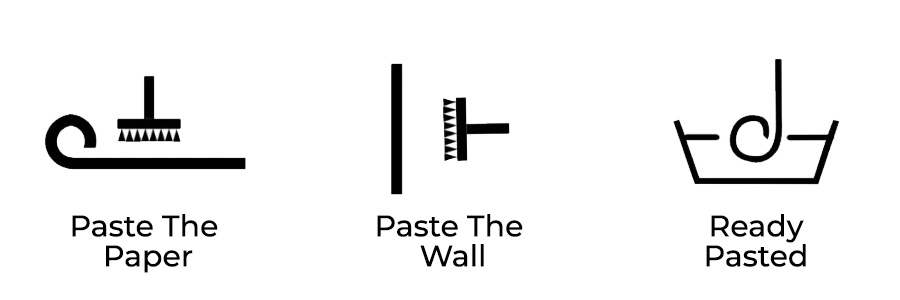
Paste the paper: This symbol is the most frequently encountered paste instruction. It involves applying paste directly onto the back of the wallpaper. Thus allowing it to soak for the recommended time, and then affixing the pasted strip to the wall.
Paste the wall: This is regarded as the easiest of the 3 options. Simply apply the paste to the wall and attach the strip of wallpaper. Some manufacturers may not include the symbol but will alternatively label the wallpaper as ‘non-woven’ which means the paste the wall.
Ready pasted: Ready pasted or pre pasted is when the wallpaper already has paste applied to the back of it. All you then have to do it place it in water to active the adhesive. For a more in depth blog post on different pastes, please go here to What’s The Difference Between Paste The Paper & Paste The Wall?
Pattern Match
Understanding your wallpaper’s pattern match is crucial when hanging wallpaper. Pattern match simply refers to how the patterns align horizontally between adjacent strips of wallpaper. If you don’t get it right or understand it, you might end up hanging the wallpaper incorrectly, which can be frustrating and a waste of both time and money. There are four main types of pattern match.
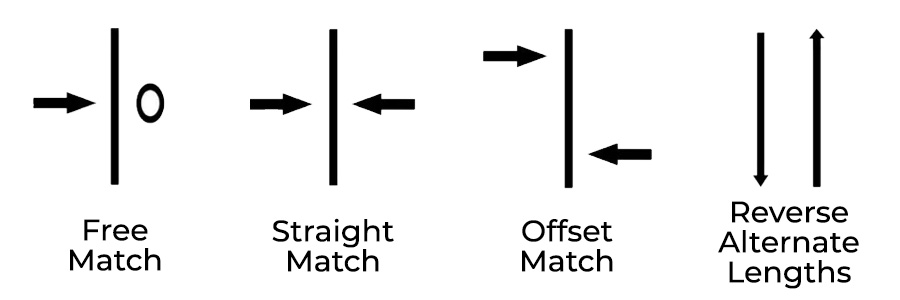
Free match: In a free match design, no alignment is necessary, making it the simplest pattern match to hang. You can place adjacent strips however you like, and the pattern will still line up. Free match results in the least amount of wasted paper compared to other available pattern matches.
Straight match: A straight match means that the design aligns horizontally across adjacent strips. The pattern from left to right on one strip will match that of the next one and continue in the same manner.
Offset match: An offset match design requires that every second strip be shifted or dropped by the distance specified in its drop match in order for adjacent strips to align. Essentially, the edge of the wallpaper will only match the edge of the second strip when it is dropped by a specific distance. The most effective technique for hanging offset match wallpaper is to cut and align the strips on a pasting table before pasting and hanging them. Offset match wallpaper typically results in the most waste.
Reverse alternate lengths: Reverse Alternate Lengths, also known as reverse hang. This is a technique commonly used with plain or lightly textured wallpaper. It involves placing adjacent strips in alternating directions, so every other strip is reversed in direction. This method is particularly employed with plain wallpaper to prevent shading.
Washability – Wallpaper Symbols
Each wallpaper is assigned a washability rating, depicted by a single wallpaper symbol on the label of the design. Failure to adhere to the appropriate washability procedure for your wallpaper can result in irreparable damage. There are five primary symbols you may encounter in this category.
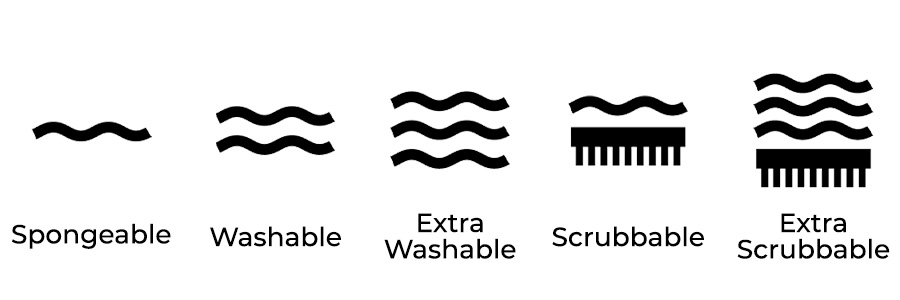
Spongeable: If you notice a single wavy line on the label, it indicates that your wallpaper is spongeable. This is the lowest washability rating, implying that to clean the wallpaper, you should use a damp but not soaking-wet sponge to delicately wipe the surface of the paper. Avoid using any cleaning fluids or chemicals, only water is recommended.
Washable: Washable wallpaper offers a bit more durability compared to a spongeable design, as denoted by a double wavy line. While it’s easier to remove surface dirt, it still necessitates a delicate approach, using a sponge without any chemicals. Applying excessive moisture or pressure may result in tearing or ripping of the paper.
Extra washable: The wallpaper symbol consisting of three wavy lines indicates that the paper is extra washable. This type of wallpaper is suitable for use in kitchens and bathrooms because it is more resistant to moisture.
Moisture Warnings
However, it’s important to note that it is not waterproof. So it should be kept away from direct water sources such as areas prone to splashing water. In other words, avoid hanging it next to a shower or sink.
Scrubbable: This wallpaper is one of the tougher paper types and is indicated by a symbol which resembles a scrubbing brush. This simply means that you can apply a little more pressure to remove dirt without the paper becoming damaged. We recommend also using a damp sponge. And still taking appropriate care and precaution as ultimately, it’s important to remember that you are still dealing with paper.
Extra scrubbable: A step up from normal scrubbable wallpaper, stains caused by dirt and water-based substances can be easily removed using a mild detergent or an abrasive cleaner. Oils and fats can also be eliminated if promptly scrubbed.
Wallpaper Removability
When examining a wallpaper label, you may encounter a symbol indicating the removal technique for that wallpaper. Understanding the appropriate strategy for removing your wallpaper in the future can save you significant time and effort in the long term. There are three primary wallpaper removal techniques.
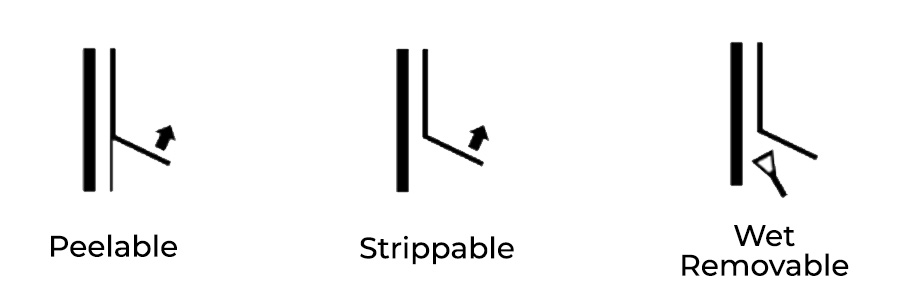
Peelable: This refers to the ability to dry-peel the decorative surface and backing from the wall, leaving a continuous layer of the substrate. This remaining substrate can serve as a liner for applying new wallpaper.
Strippable: Strippable wallpaper allows you to remove the entire wallpaper in one strip while it is dry. When removing the wallpaper, both the front and back layers will come off the wall simultaneously.
Wet removable: This type of wallpaper can only be taken off the wall with a liquid solution like a stripping agent or by soaking it with water. Then, you’ll have to manually scrape off the excess paper.
Light Fastness
Light fastness refers to how well your wallpaper retains its color when exposed to sunlight. Over time, any wallpaper, and even some materials, may fade when directly exposed to sunlight. Light fastness helps determine which wallpaper will maintain its colour longer in areas with higher sun exposure and which are better suited for walls and rooms with less direct sunlight.
The wallpaper symbols indicating light fastness are as follows: moderate, satisfactory, good, and very good. For a wall that receives ample natural sunlight, such as one near a window, it’s advisable to choose a wallpaper with a high light fastness rating.
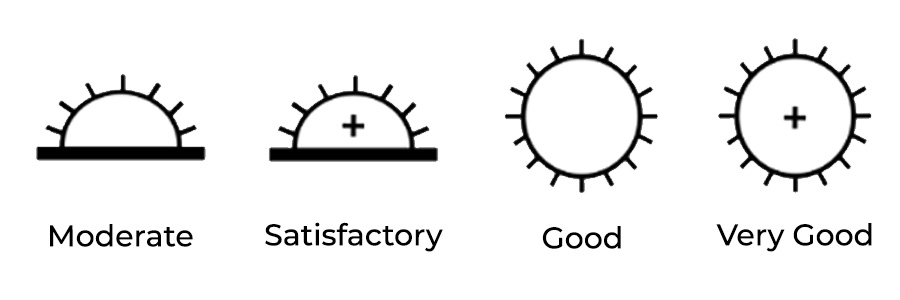
If you require any more assistance on wallpaper symbols for whatever reason, please do not hesitate to send us an email with your enquire. And please follow us on Instagram for all wallpaper inspiration,
